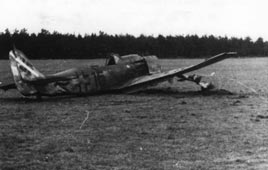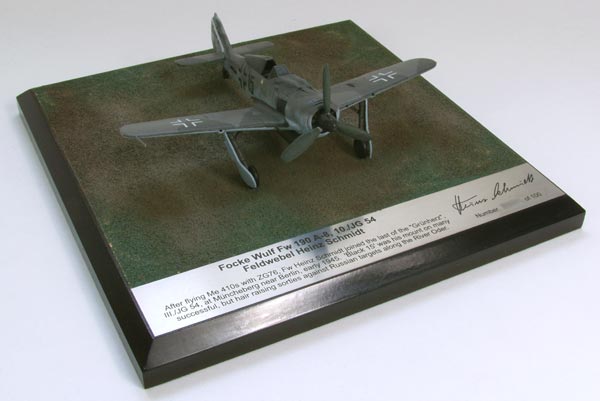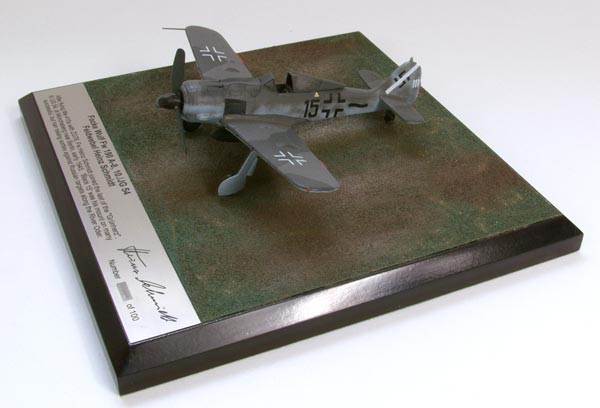Focke Wulf Fw 190A-8
Focke Wulf Fw 190A-8 ‘111’ ‘Black 15’ Wk Nr unknown
III./JG 54 / ‘Grunherz’, Heinz Schmidt, River Oder, Spring 1945.
Famously known as the ‘Butcher Bird’ the Focke Wulf Fw 190 was a formidable foe to any allied aircraft and pilot. This versatile aircraft saw service in North Africa and on the Russian front and was used in all roles from ground attack to inttercepting allied bomber formations in close combat. The Focke-Wulf Fw 190A-8 was the final sub-type of the fighter version of Kurt Tank’s design powered by the BMW 801 radial engine, and the variant produced in the greatest numbers. The Fw 190A-8 added a liitle more internal fuel to earlier marks, and had various armament fits, including as on this example an under-fuselage bomb-rack when used as a fighter-bomber. This particular Fw 190A-8 has two 20 mm MG 151 cannon in the wing roots with two more in the outer wing sections, and two 13 mm MG 131 machine guns mounted in the forward fuselage. Jagdgeschwader 54 spent most of its operational service on the Eastern front, and although noted for its creative approach to unusual camouflage patterns and colours, this Fw 190A-8 is finished in the standard later-war grey colours. The white stripe on the fin often denoted a formation leader in the late stages of the war, and the white 111 may be the last three digits of the Werk Number.
Heinz Schmidt was born in Halberstadt, Sachsen-Anhalt, 1922 . His first real link with aviation was when he became a Junkers aircraft apprentice. When war broke out in 1939 he joined the Luftwaffe and was trained as an airframe mechanic. He made several applications to remuster as aircrew, but his superiors said that an ex Junkers apprentice was more use to the Luftwaffe on the ground than in the air!
For the duration of the Battle of Britain, Heinz Schmidt served with KG 77 and also experienced the opening phase of the Russian Campaign in 1941.
In that same year his application for pilot training was finally accepted and he quickly found himself on the way to Flugzeugfuhrerschule A/B 23 at Aufbouren for primary flying training. From biplanes he progressed to twin-engined aircraft and finally qualified on the Do 217.
In 1943 he was posted to KG 100 where, to his total disgust, he was required to fly the ‘lame’ He 111.When Goring called for Luftwaffe bomber pilots to volunteer for fighter pilot training in 1944, Heinz Schmidt lost no time in getting away from KG 100. His twin- engine training paid dividends and he quickly learnt to fly the Bf 110 with ZG 101 at Memmingen. To his great delight a posting followed to ZG 76 and the Me 410 Hornet, an aircraft that he loved to fly and greatly respected.At the end of 1944 ZG 76 was disbanded and its pilots formed the nucleus of the new III./JG 54, ‘The Last of the Green Hearts’. Operating from Muncheberg, near Berlin, the unit’s Fw 190s saw intensive action against Russian ground targets such as, road and rail supply columns, flak positions, armour and the bridges across the River Oder.
A few weeks before the war ended, III./JG 54 was also disbanded and Heinz Schmidt packed his bags and headed for JG 2 ‘Richthofen’ which had just re-equipped with the Fw 190 D-9. Happy though he was to fly this excellent fighter, the realities of having to fight an overwhelming enemy with no fuel and ammunition only served to strengthen his will to survive at all costs.When the post-war German Air Force was activated in the mid-fifties, Heinz Schmidt returned as an instructor and trained hundreds of young pilots on the
Havard Mk IV and Fouga Magister at FFS ‘A’ Landsberg. Some ten years later he was commissioned and joined the Flugdienststaffel (Facilities Squadron) at Kaufbeuren, the same base where he had learnt to fly back in 1941. His final years before retirement in 1977 as a Captain were spent flying the ‘the most harmless aircraft of his career’, the Dornier Do 28 and the Piaggio Pi 149.

Scale 1:72 Wingspan 5.74″ (146 mm)
Base size 7.71″ (196 mm) square (No. 5)
Weight not including base 8.25 ozs (235 grams)
Limited edition of 100 only Total number of models produced 100



